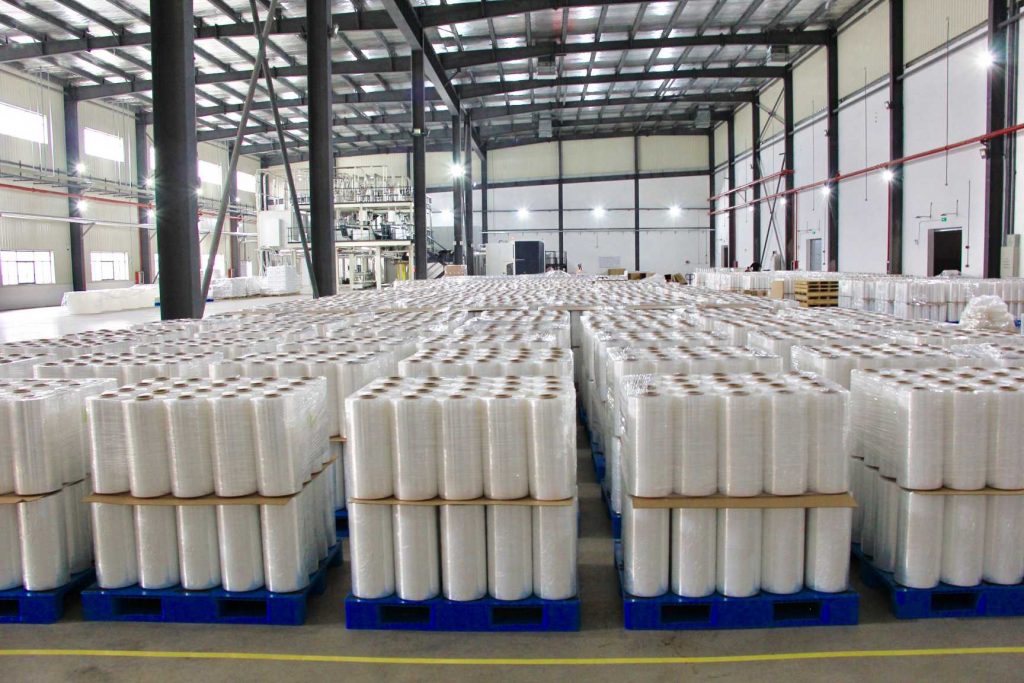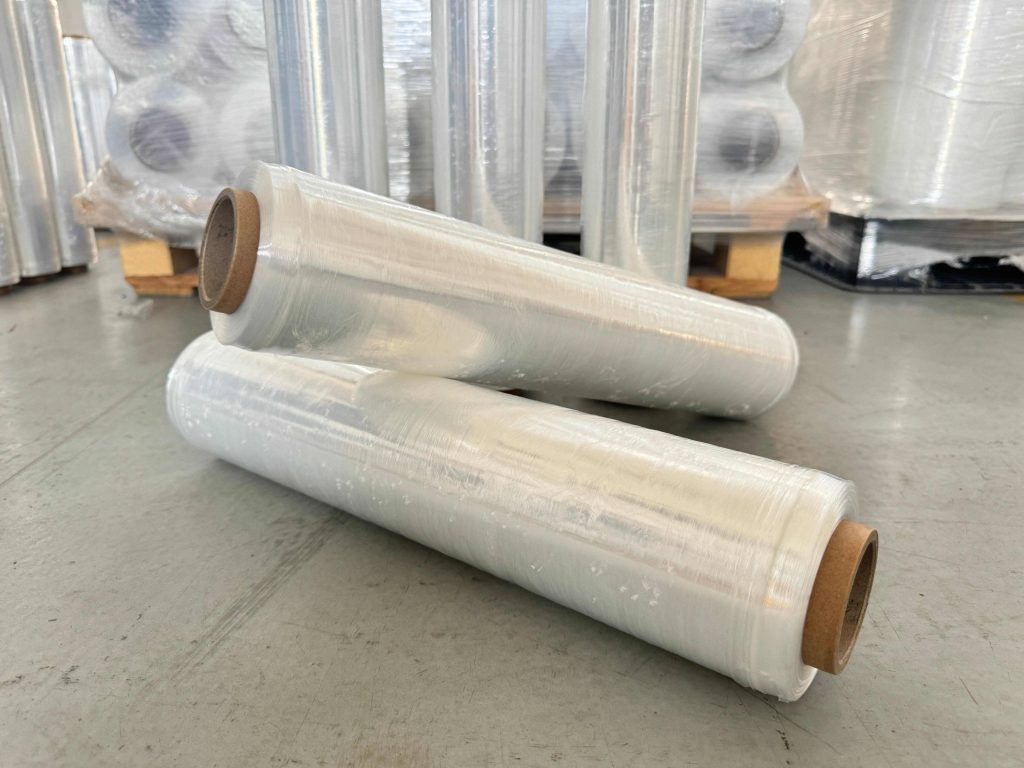In the world of modern packaging and logistics, stretch film is more than just a layer of plastic wrap—it’s a strategic tool for safeguarding products, streamlining operations, and reducing shipping damage. Whether you’re in food distribution, electronics, manufacturing, or retail logistics, choosing the right stretch film manufacturer is critical to maintaining packaging efficiency, product integrity, and bottom-line profits.
This comprehensive guide explores everything you need to know about stretch film, its production process, types, industry applications, and how reputable manufacturers—like Sinyar Packing Film—are setting the global benchmark for quality and innovation.

What is Stretch Film?
Stretch film, also known as stretch wrap, is a highly stretchable plastic film typically made from linear low-density polyethylene (LLDPE). It’s used to tightly wrap and secure products—especially palletized goods—during storage or transportation.
The key characteristic of stretch film is its elasticity, which allows it to cling securely to itself and tightly hold loads together, providing:
- Load stability
- Protection against dust and moisture
- Tamper resistance
- Packaging uniformity
Why Stretch Film Matters in Packaging
Stretch film plays a vital role in packaging by offering several operational and financial benefits:
- ✅ Prevents product shifting during shipping
- ✅ Reduces load damage and returns
- ✅ Improves warehouse safety and stacking
- ✅ Cuts down on packaging material waste
- ✅ Enables automated high-speed pallet wrapping
It’s no wonder that stretch film is a preferred solution across logistics hubs, fulfillment centers, and supply chains worldwide.

Common Types of Stretch Film
Understanding the available types of stretch film can help businesses choose the right solution for their operations:

1. Hand Stretch Film
- Designed for manual wrapping
- Ideal for low-volume operations
- Lightweight and easy to handle

2. Machine Stretch Film
- Compatible with automatic and semi-automatic stretch wrappers
- High stretchability (up to 300–400%)
- Perfect for high-volume packaging lines

3. Pre-Stretch Film
- Already stretched during manufacturing
- Requires less force during application
- Reduces film consumption and improves ergonomics

4. Specialty Stretch Films
- UV-resistant films for outdoor storage
- Anti-static films for electronics
- Colored or printed films for branding or identification
Blown vs. Cast Stretch Film
There are two main manufacturing techniques:
| Feature | Blown Film | Cast Film |
|---|---|---|
| Production Method | Blown through a circular die and cooled by air | Cast on chill rollers and cooled quickly |
| Clarity | Less clear | Highly transparent |
| Strength | High puncture resistance | Smoother and quieter unwind |
| Cost | Slightly higher | Economical and faster to produce |
| Use Case | Heavy or irregular loads | General purpose, automated lines |
Both methods produce durable films—each with strengths suited to different applications.
How Stretch Film is Manufactured
The manufacturing of stretch film involves advanced polymer science and precision machinery. Here’s a simplified overview:
- Raw Material Selection
- LLDPE resins are combined with additives (for UV, color, cling, etc.)
- Co-Extrusion
- Multiple layers are extruded simultaneously to enhance performance
- Typical films have 3, 5, or 7 layers
- Cooling & Winding
- In cast film, molten polymer is chilled on rollers
- Blown film is cooled by air and rolled onto cores
- Quality Testing
- Films are tested for thickness (gauge), stretchability, cling, and clarity
Sinyar Packing Film uses high-speed co-extrusion lines and stringent quality control protocols to ensure consistent film performance across global markets.

Key Qualities of a Reliable Stretch Film Manufacturer
Not all stretch film producers are equal. Leading manufacturers are distinguished by:
✅ Technical Expertise
- Deep knowledge in polymer formulation and extrusion
- In-house R&D capabilities
✅ Consistent Quality Assurance
- Lab testing for tensile strength, puncture resistance, and elongation
- Certifications like ISO, SGS, or RoHS
✅ Customization Options
- Ability to tailor film thickness, color, width, core diameter, and more
- OEM/ODM support for global distributors
✅ Responsive Customer Service
- Technical support for film-machine compatibility
- Fast lead times and global logistics

Stretch Film Applications Across Industries
| Industry | Application |
|---|---|
| Logistics & Freight | Wrapping and securing pallet loads for transport |
| Food & Beverage | Ensuring hygiene and containment of food cartons |
| E-Commerce | Protecting packages during last-mile delivery |
| Pharmaceuticals | Securing medical products in sterile conditions |
| Electronics | Anti-static wraps to protect sensitive components |
| Construction Materials | Wrapping irregular, heavy loads like tiles or cement |
Understanding Stretch Film Specifications
Before partnering with a stretch film manufacturer, it’s crucial to understand the key technical specifications that impact performance and compatibility:
| Specification | Description |
|---|---|
| Gauge (Thickness) | Typically ranges from 8μm to 30μm (microns). Thicker film = more puncture resistance. |
| Stretch Ratio | The percentage the film can be stretched from its original length. (e.g., 250–300%) |
| Cling Properties | Ensures layers stick together without adhesives, reducing unraveling. |
| Tensile Strength | Resistance to being pulled apart—key for load stability. |
| Tear Resistance | Determines how well the film holds up against sharp edges or shifting cargo. |
| Roll Dimensions | Width (usually 500mm), length (1000–3000m), and core size (commonly 3″) |
| UV Resistance | For outdoor storage, films may include UV inhibitors for 6–24 months protection. |
By matching these specs to your equipment and load type, you ensure optimal wrap performance and cost-efficiency.

Global Trends in Stretch Film Production
The stretch film industry is constantly evolving, driven by sustainability goals, automation, and increasing global trade. Major trends include:
♻️ 1. Eco-Friendly Stretch Films
- Downgauging: Creating thinner films with higher strength to reduce plastic use.
- Recyclable materials: Most LLDPE films are 100% recyclable.
- Biodegradable additives: A growing innovation, especially in eco-regulated markets.
🤖 2. Automation and Smart Packaging
- Compatibility with high-speed pallet wrappers
- Sensor-enabled packaging systems that measure wrap force and pallet integrity
🌍 3. Localization of Supply
- Manufacturers are setting up production closer to demand zones to cut delivery times.
- Export hubs like China are still dominant, offering cost-effective mass production.
China as a Global Hub for Stretch Film Manufacturing
China is home to some of the world’s most advanced stretch film manufacturers, thanks to:
- 🏭 High-capacity production plants
- 🧪 Strong R&D in polymer engineering
- 📦 OEM/ODM capability for private-label global brands
- 🚚 Competitive pricing and fast logistics support
Sinyar Packing Film, located in the heart of China’s manufacturing belt, is one such globally recognized supplier—providing stretch film to clients across Asia, Europe, the Americas, and the Middle East.

Sinyar Packing Film – A Trusted Global Stretch Film Manufacturer
With decades of experience in the stretch packaging industry, Sinyar Packing Film has built a reputation for quality, flexibility, and innovation. As a leading stretch film manufacturer, the company services clients ranging from logistics providers to retail chains, food producers, and industrial packagers.
✅ What Makes Sinyar Stand Out
- Advanced 5-layer & 7-layer co-extrusion machines
- Global export capabilities with fast turnaround
- Strict quality inspection on every batch
- Low MOQ for new customers and startups
- Sustainable product lines with downgauged film
Whether your business requires custom machine film rolls or eco-friendly hand wrap, Sinyar delivers consistent quality at competitive prices.
📦 Product Portfolio Overview
| Product | Description |
|---|---|
| Hand Stretch Film | Lightweight, strong, and ergonomic—ideal for manual applications. |
| Machine Stretch Film | High-performance wrap compatible with automatic systems. |
| Pre-Stretch Film | Pre-elongated for easy application and reduced material use. |
| Colored Stretch Film | Black, white, green, and blue wraps for branding or inventory control. |
| UV Stretch Film | Designed for outdoor wrapping with long-term sun protection. |
Every product can be customized in terms of color, gauge, stretch %, and core specs.
How to Choose the Right Stretch Film Supplier for Your Business
Selecting the right stretch film manufacturer is not just about cost—it’s about total value, which includes reliability, support, and long-term partnership potential.
Here’s a checklist to evaluate:
| Criteria | Why It Matters |
|---|---|
| Product Range | A broad portfolio ensures the supplier can scale with your needs. |
| Customization Capability | Enables tailored specs for unique packaging machines or load types. |
| Certifications | ISO 9001, REACH, SGS, or FDA approval can be crucial for compliance. |
| MOQ & Pricing | Look for flexible minimums and transparent pricing models. |
| Customer Support | Prompt technical and post-sale service reduces operational risk. |
| Lead Time & Logistics | A good supplier respects deadlines and helps manage freight smoothly. |
Conclusion: Why the Right Manufacturer Is Your Competitive Advantage
Choosing the right stretch film manufacturer is more than just finding a supplier—it’s selecting a strategic partner in your packaging and supply chain operations. A good manufacturer ensures:
- Consistent quality and supply
- Technical support to reduce downtime
- Scalable solutions as your business grows
- Access to innovation and sustainable options
Companies like Sinyar Packing Film stand at the forefront of global stretch film manufacturing. With a proven track record, world-class production, and a commitment to customer satisfaction, Sinyar remains a trusted partner for businesses seeking reliable and efficient packaging solutions.
FAQs About Stretch Film Manufacturers
Q1: What is the lead time for custom stretch film orders?
Typically 7–15 days depending on order size and customization needs.
Q2: Can I order stretch film with private branding?
Yes. Many top manufacturers like Sinyar offer full OEM/private label services.
Q3: Are all stretch films recyclable?
Most are made of LLDPE and are recyclable under plastic category #4.
Q4: How do I know the film is of good quality?
Look for certifications, technical data sheets, and request samples for testing.
Q5: Does film gauge affect cost and performance?
Yes. Thinner films are more economical but must be engineered for high strength to avoid failure.
Q6: What’s the difference between 5-layer and 7-layer film?
7-layer films offer improved cling, stretch, and load containment—great for heavy-duty loads.
Q7: Can stretch film be used in cold storage?
Yes, specialized cold-resistant films are available for freezer environments.
Q8: How does Sinyar support international buyers?
With multilingual support, fast quotes, documentation for customs, and global shipping coordination.




